
Four risks healthcare executives should monitor in 2018
With the right preventions in place, hospitals and healthcare executives will be well positioned to respond to these four risks in 2018.
The healthcare industry saw big changes in 2017. While the debate over the ACA dominated the headlines, it was just the tip of the iceberg as consolidation continued at rapid speed, prescription practices came under scrutiny and the country embarked on a discussion about healthcare costs.
If hospital and healthcare executives thought 2017 was busy, they are in for a rollercoaster of 2018. Fortunately, while this year was marked by several unforeseeable developments, the 2018 forecast looks more predictable, especially as it relates to emerging medical liability exposures. With the right preventions in place, hospitals and healthcare executives will be well positioned to respond.
Here’s four things you should know.
1. The opioid crisis isn’t going away.
The United States is in the middle of an opioid epidemic, with the
Given the link between overdoses and legally prescribed opioids, providers face growing scrutiny over their prescription behavior, especially sub-standard practices like failing to consider alternative treatments or obtaining informed consent. If a patient is harmed or injured, providers can potentially face both professional and criminal liability.
With no community left untouched by the crisis, every healthcare organization should develop an opioid prescription risk management plan for 2018. This six-part plan is an effective approach to curbing exposure and should begin with designating a clinical leader responsible for the oversight of pain management and safe opioid prescribing across the organization. Other elements should include:
· Level-specific recommendations for educating clinicians about safe opioid use.
· Guidelines for safe opioid prescribing and dosing for post-operative and chronic pain.
· Criteria for screening and assessing patients for addiction exposure based on diagnosis, planned treatments and risk for respiratory depression upon admission.
· Resources for patient education on safe opioid treatment, including risks, side effects, potential for sedation, the danger of polypharmacy, and safe storage and disposal at home.
· Protocols for handling patients with drug-seeking behavior who present in the emergency department, including how to assess red flags that could signal misuse.
2. Missed and/or delayed infection diagnoses can lead to catastrophic injuries.
An infection, if caught early, can usually be treated with antibiotics. In some cases, however, an undiagnosed infection can lead to sepsis and devastating consequences, including amputations, organ damage, paralysis and even death.
This is a meaningful challenge providers must contend with. To put it in perspective, the
Developing an effective infections prevention strategy is critical to reducing this exposure. This strategy should include resources for supporting ongoing infection surveillance, data collection and analysis. Clinical training and education are also important, particularly around triage, early recognition and intervention, and treatment best practices. With so much at stake, healthcare organizations should put infection control and prevention at the top of their risk management and patient safety 2018 agenda.
3. Violence is on the rise.
While healthcare organizations are places of care and healing, they are prone to violence. Between 2012 and 2014, the
Beyond putting employees and patients at physical risk, violence in hospitals can lead to a host of insurance implications. Medical professional liability and worker’s compensation claims, for instance, can be triggered if a patient or employee is harmed or injured. Violence can also activate general liability, property, and directors and officers (D&O) coverages. Even with these protections in place, such an incident can result in significant financial consequences.
While hospitals and healthcare organizations have already committed millions to protect employees, patients and their facilities, the new year calls for updating each organization’s workplace violence prevention program. Such a program should be based on an enterprise-wide risk assessment plan and shepherded by a multidisciplinary committee to ensure no department is overlooked. Upon the completion of that plan, organizations should commit to training staff on key violence prevention measures, including how to deliver bad news and warning signs to monitor. Most importantly, staff should receive in-depth instruction on when to try and diffuse a situation, when to retreat to safety, and how to notify authorities.
4. Long-time staff invite new risk
Thanks to advancements in science and medicine, older adults are living longer than ever, including providers who are working long past traditional retirement age. In fact, the
While the sensitivity of this topic is understood and we respect the experience of aging physicians and the unique insight they provide, from a patient safety standpoint it cannot be ignored. In turn, and while healthcare organizations need to be cautious about inadvertently implementing age-based discriminatory practices, they must take the necessary steps to reduce their malpractice and corporate liability exposures. Developing detailed and compliant policies for addressing aging physicians and safe delivery of care is the critical first step. In some cases, this might include implementing mandatory age-based physicals and competency testing. In others, it could be introducing part-time or flexible schedules that foster a transition to a teaching or mentor role.
Regardless of the measures taken, healthcare organizations should act now and proactively have a plan in place.
No time like the present
While these challenges might appear daunting, there are a number of simple risk mitigation steps available to help limit an organization’s liability. The steps are practical, but require experienced staff, time, resources, teamwork, and commitment from administration and all leadership.
As 2018 approaches, executives should begin to take action now by making sure they are familiar with each of these emerging risk and ensuring they have a comprehensive risk management program in place. Coupled with appropriate insurance coverages, hospitals and healthcare organizations can better fulfill their primary mission and deliver the best care to their patients.
Diane Doherty is senior vice president of Chubb Healthcare. She can be reached at
Newsletter
Get the latest industry news, event updates, and more from Managed healthcare Executive.


















































